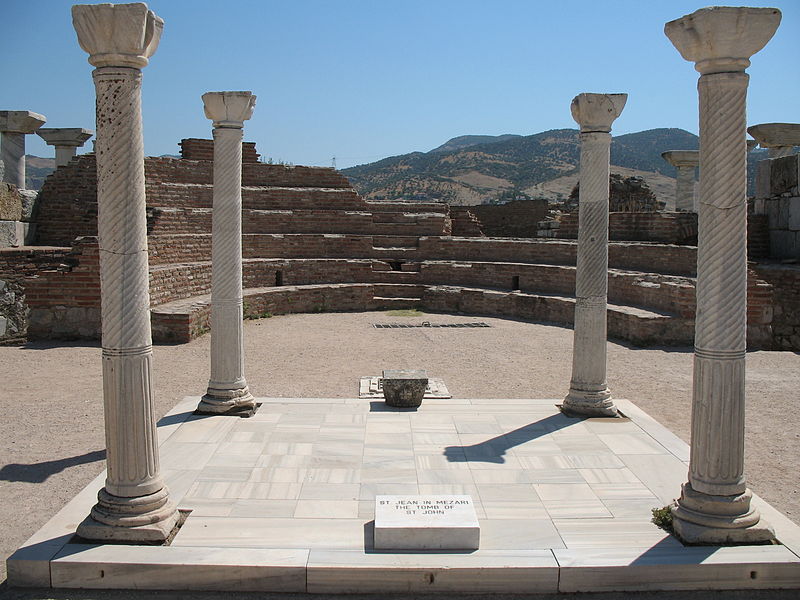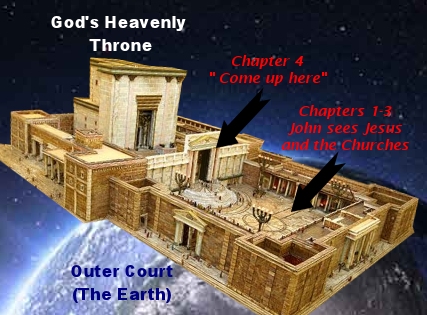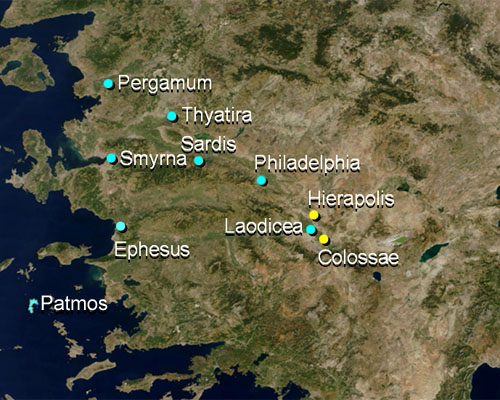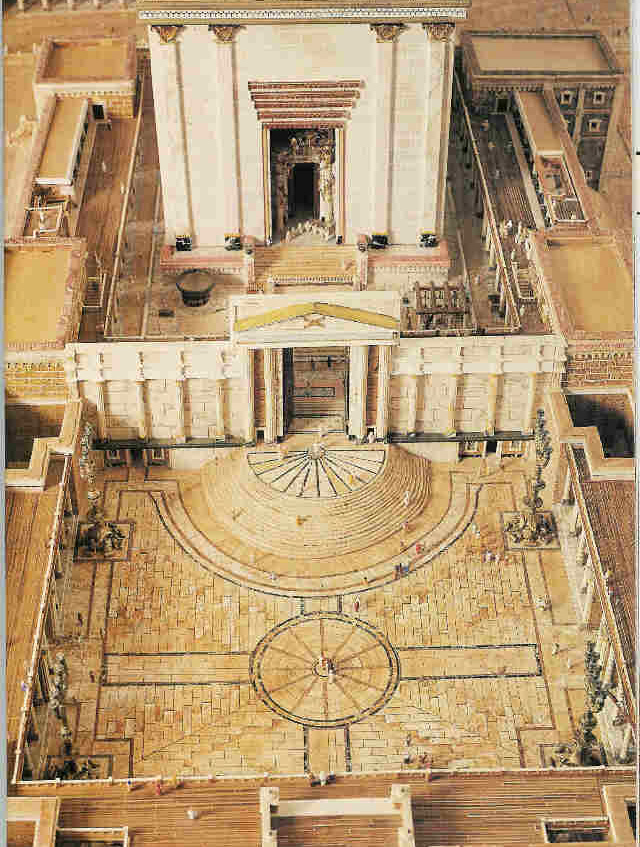"A New Approach to Revelation" by Tricia Tillin (Part Six)
how the day of atonement Temple service sheds light on the book of revelation: The Seven Letters
Starting out at the first chapters of Revelation, we encounter John on the Isle of Patmos where he has been exiled for his faith. Across the Mediterranean Sea is the mainland of Asia Minor, where he has many Christian friends and fellow-workers. Church tradition (that cannot be fully substantiated) says that John was a pastor in the church in Ephesus and had a special relationship with other churches in the area, but this we do know from the letters to the Seven Churches in his book.
There is also a church tradition that places John at Ephesus along with Mary the mother of Jesus for a few years. After his exile on Patmos, John apparently returned to Ephesus and is buried there [see his tomb below]. So there is an affectionate link with the writer of Revelation and the Asian churches.

NOTE: Why did John mention only seven churches? This may have been for prophetic purposes, or to use the biblical number of perfection, seven, or it may just be that he wrote his vision at a time when there WERE only seven churches active in the area. This tricky question is explored elsewhere. See the Index Page.
The Initial Setting
As you will see from the illustration below, I have used my knowledge of the Temple Courts and the Book of Revelation together to suggest that at the beginning of his vision - when John first encounters the Lord Jesus, the High Priest of our salvation - he is situated in what is called the Women's Court.
If you have read Part Five you will know that this Court with four huge candelabra was open to all bona fide people of Israel. In symbolic and prophetic terms, however, it is the place for believers. Rev 22:14,15 "Blessed are those who wash their robes, so that they may have the right to the tree of life, and may enter by the gates into the city. Outside are the dogs and the sorcerers and the immoral persons and the murderers and the idolaters, and everyone who loves and practices lying."
So John, in prayer and worship before the Lord, is transported in mind and spirit to the "Day of the Lord", the Judgement Day. Remembering his experiences of the Second Temple in Jerusalem, he recalls the Day of Atonement ceremonies and likens that to the coming time of cleansing, redemption and wrath when Jesus will be enthroned as King, and God once more dwells with men.

The Ascension
John knows that seven days before that Yom Kippur ceremony, the Jewish High Priest will have been escorted to his chambers in the Temple.
There he ministers, reads the scrolls of the Law, and practises his part in the great DAY to come. "During the whole of that week, he would perform all the Temple duties, such as burning the incense, lighting the lamps, offering the daily sacrifice, etc. In addition, he would study two Torah portions and learn them by heart to make sure he didn't make any mistakes. On the eve of the Day of Atonement, the High Priest would stay up all night learning Torah and preparing himself spiritually. If he fell asleep, young priests woke him up by reciting psalms." [Source]
However, now the only High Priest is Jesus Christ. When John encounters the Lord he sees him wearing priestly garments. (Rev 1:13 compare 15:6) But the time for the service is not yet.
So, as I said, the Jewish High Priest would have entered the Temple SEVEN DAYS before the important Feast of Yom Kippur, while the "Days of Awe" ran their course. Although the Books of Life and Death had been opened, the final decision about whose names would be entered there had not been taken. It was a time for fasting and solemn reflection, for repentance and getting right with God!
Going back to the Book of Revelation, do we see these facts reflected there? YES. When John sees the risen Lord, before the Day of Atonement ceremony begins in earnest, there are SEVEN letters to inscribe. These letters represent both the seven days that the High Priest spends inside the Temple, and the seven ages that had to pass before the Day of Judgement could come.
Our High Priest goes to the Temple
Jesus Christ our High Priest fulfilled this type. Before the final Day, he ascended from his earthly home to the heavenly Temple, there to minister on our behalf. There - the bible tells us - he has been "waiting" (Heb 10:13) for the Day of Judgement to begin. Meanwhile, not just seven days, but seven ages pass. And just as the trumpet sounds on each one of the Jewish "Days of Awe" to call Israel to repentance, so the gospel trumpet is sounded day by day to call people to repent and believe before it's too late. The great DAY is coming when the Books will close and no further names will be entered.
So I believe that apart from the obvious and genuine prophetic message to each church in Asia, we have in Chapters 2-4 of Revelation a prophecy of the seven AGES of the Church. During those seven ages, as Jesus awaits his endtimes role in the Heavenly Temple, the Church goes out into all the world to preach the gospel - either effectively or not, as the case may be.
![]() Go Back to Summary/Contents Page
Go Back to Summary/Contents Page
The Seven Ages of the Church
This important study on the meaning of the seven letters to the churches has been more fully explored on many websites across the Net. (For one example, see HERE). I have a short study of my own on this website which you can read here. However, on this page I will briefly run through the seven churches in history and show how the expansion and decline of the Church leads in a very prophetic way towards the final call.
This is not to say that the letters were simply prophetic, not historical. God's amazing wisdom, foreknowledge and ability to know the end from the beginning means that the letters were just as relevant to the seven Asian churches as they are to the Church as a whole. But below I attempt to point out the phases that the worldwide Church experienced from the resurrection of Christ until today.

Before I begin, it's important to realise that these are not isolated churches that die out when their day is done. This is an overview of the progression of the Church as a whole, in its ups and downs. We still see representatives of each of these attitudes and denominations. For example, the Roman Catholic Church did not end in 1517.
- Ephesus: THE MISSIONARY CHURCH - The early church with its missionary zeal but slow decline into the "loss of its first love" and fervour. This early phase lasted from Pentecost to the onset of universal hatred and persecution, and the consequent end of open mission. (30AD to 250AD)
- Smyrna: THE PERSECUTED CHURCH - Historians often list TEN ten major persecutions in the early church, reflecting the "ten days" of suffering that Jesus prophesied of Smyrna. It began under Nero but was sporadic until 250AD when Decius issued an edict requiring all citizens to sacrifice to the emperor in the presence of a Roman official. (250-313AD)
- Pergamos: THE STATE CHURCH - Persecution ended when Constantine declared himself a Christian in 312 AD. His Edict of Milan the following year offered tolerance and acceptance to the Christian Church. State persecution by the Romans ended. However this was a mixed blessing, as anybody could claim to be a Christian without fear. Consequently the Church became more and more pagan and organised, with the priesthood, legalism and various rites making a reappearance.. Marcellinus, reputed to be the first "pope", was elected in 296 and Siricus the first "Bishop of Rome" in 384. The last Roman Emperor was killed in 480 and Rome and Constantine were shaken by a huge earthquake. (313-480 AD)
- Thyatira: THE CORRUPTED CHURCH - For many centuries thereafter the Church was riddled with greed, corruption, immorality, paganism and false religion. Secret societies such as Freemasonry rose up, and the power and domination of the priesthood grew immense. True Christianity was driven underground. In December 800 Charlemagne was crowned king of the Holy Roman Empire. In 1053, the first step was taken in the process which led to formal schism between the Roman Church and the Greek. The Roman Catholic Church ruled in Europe and much of the rest of the world. But slowly, and gaining momentum after 1300AD, reform challenged this dire situation. Eventually in 1517 Luther nailed his theses to the Church door. (480-1517)
- Sardis: THE FLESHY CHURCH - After the Reformation, the Church had increasing liberty to spread the gospel but it became apathetic and tradition-bound instead. It was slow to throw off the paganism and dead rituals of the previous centuries. It had the name of life but was dead. Persecution and dissatisfaction led to many small breakaway cults and denominations arising, who sought to purify the message of the Church. From around 1730 there was an evangelical and spiritual renewal. Wesley was saved in 1738. Whitfield preached from 1740. (1517-1742)
- Philadelphia: THE PURIFIED CHURCH - From 1742 what we now call the Great Awakening took place, and revival influenced many to break away from dead traditional churches. The power of God in the Holy Spirit was rediscovered, and the gospel began to be preached effectively once more. (1742-1960)
- Laodicea: THE LAX CHURCH - In the 1960's many things had changed in the post-war world. New Age teachings, Spiritism, Humanism and Philosophy became popular and the Church lost its way, turning to cultist practises and heresies to please the flesh. This descent into selfish indifference tested the faith of all Christians and remains the situation to this day. In 1960 American Episcopalian Dennis Bennett claimed to have received the Holy Spirit, and the term "charismatic" was coined by American Lutheran minister Harald Bredesen in 1962. However, along with a genuine renewal of the gifts and ministries of the Spirit, false teachings and manifestations crept in and gradually replaced the genuine. That brings us to the Church of today!
I realise that this list above raises many questions and leaves many others unanswered. This particular study is not the place for an extended study of the Seven Churches, but I have tackled it separately, so anyone who would like to follow up my statements should go to the specific page on the Seven Churches of Revelation. Click HERE
On with the Revelation study...
Having avoided the temptation of a major diversion into speculation about the letters to the seven churches, we can now return to the subject in hand. Once Jesus has instructed John to write to the seven churches, indicating both John's present-day and ours, the situation and location changes.
 Leaving his earthly location as symbolised by the Woman's Court [in the front portion of this illustration], John is invited (as the service begins) to "come up here" to see what takes place 'afterwards'.
Leaving his earthly location as symbolised by the Woman's Court [in the front portion of this illustration], John is invited (as the service begins) to "come up here" to see what takes place 'afterwards'.
This is not only a prophetic statement but a literal one in the case of the Day of Atonement, because at this point in the service the 24 Israelite representatives of the nation, suitably purified, would mount the 15 steps to the inner court and take their place in front of the altar that stood before the Sanctuary itself.
There they would see the officiating priesthood, the great altar of sacrifice, the "bronze sea" and the doors of the Sanctuary itself.
This indeed is what happens to John. He leaves the place of ordinary worship and mounts up the steps to the massive Nicanor gate which takes him, symbolically and literally, from earth to heaven. We take up his story on the next page.
If you are interested, intrigued, confused, or just want to give me some feedback, please e-mail me direct: Contact Page
© 2014 Tricia Tillin-Booth. All rights reserved. Birthpangs Website: http://www.birthpangs.org/ This document is the property of its author and is not to be displayed on other websites, redistributed, sold, reprinted, or reproduced in printed in any other format without permission. Websites may link to this article, if they provide proper title and author information. One copy may be downloaded, stored and/or printed for personal research. All spelling and phraseology is UK English.
